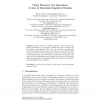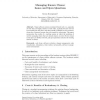DAGSTUHL
2006
15 years 2 months ago
2006
Abstract. We propose a new algorithm for the computation of the minimal associated primes of an ideal. In [1] we have introduced modifications to an algorithm for the computation o...
115
Voted
DAGSTUHL
2006
15 years 2 months ago
2006
Abstract. The talk focused on a grammar-based technique for identifying redundancy in program code and taking advantage of that redundancy to reduce the memory required to store an...
DAGSTUHL
2006
15 years 2 months ago
2006
Abstract. Code "clones" are similar segments of code that are frequently introduced by "scavenging" existing code, that is, reusing code by copying it and adapt...
100
Voted
DAGSTUHL
2006
15 years 2 months ago
2006
Many software systems contained cloned code, i.e., segments of code that are highly similar to each other, typically because one has been copied from the other, and then possibly m...
DAGSTUHL
2006
15 years 2 months ago
2006
Abstract. An overview of the concept of program similarity is presented. It divides similarity into two types--syntactic and semantic-and provides a review of eight categories of m...
DAGSTUHL
2006
15 years 2 months ago
2006
This report discusses terminology choices and considerations relating to copied or redundant code within software systems, i.e., relating to "code clones." Inadequacies o...
DAGSTUHL
2006
15 years 2 months ago
2006
DAGSTUHL
2006
15 years 2 months ago
2006
An objective definition of what a code clone is currently eludes the field. A small study was performed at an international workshop to elicit judgments and discussions from world ...
DAGSTUHL
2006
15 years 2 months ago
2006
DAGSTUHL
2006
15 years 2 months ago
2006
Abstract. An original method of spectral similarity analysis for plagiarism detection in university project is presented. The approach is based on a clone detection tool called CLA...


